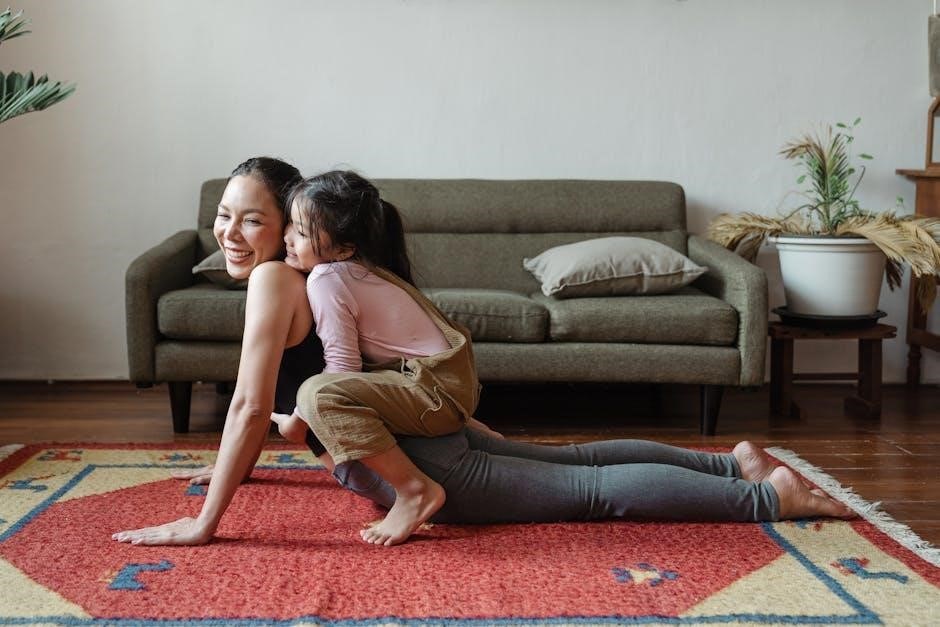Understanding the Psoas Muscle
The psoas muscle is a deep, long muscle connecting the spine to the femur, playing a crucial role in hip flexion and posture. It supports core stability and movement efficiency, making it essential for both mobility and preventing lower back pain.
Anatomy and Location
The psoas major is the largest and strongest muscle in the hip flexor group, originating from the lumbar spine (L1-L5) and inserting on the femur. It runs deep within the abdominal cavity, merging with the iliacus muscle to form the iliopsoas, which plays a key role in hip flexion and lower back stabilization. Located near vital organs and nerves, the psoas muscle is essential for movement, posture, and core stability. Its deep position makes it prone to tightness, especially with prolonged sitting or poor posture, often leading to discomfort and mobility issues.
Function and Role in Movement
The psoas major is the primary muscle responsible for hip flexion, enabling movements like walking, running, and climbing stairs. It works alongside the iliacus to form the iliopsoas, which stabilizes the lumbar spine and pelvis during movement. This deep muscle is essential for maintaining posture and facilitates smooth transitions between sitting and standing. A tight or imbalanced psoas can lead to lower back pain and limited mobility. Stretching and strengthening the psoas are crucial for enhancing flexibility, improving posture, and preventing injuries, ensuring optimal movement and overall musculoskeletal health.
Importance for Posture and Mobility
The psoas muscle plays a vital role in maintaining proper posture by stabilizing the lumbar spine and pelvis. When the psoas is tight or imbalanced, it can pull the lower back out of alignment, leading to poor posture and discomfort. Proper psoas function is essential for mobility, as it facilitates smooth hip movement and transfers forces between the legs and torso during activities like walking or running. A healthy psoas supports efficient movement patterns, reducing the risk of injury and improving overall physical performance. Stretching and strengthening this muscle can enhance posture, reduce pain, and promote fluid, effortless motion.

Causes of Psoas Tightness and Pain
Muscle imbalances, prolonged sitting, and high-impact activities often lead to psoas tightness. Poor posture and overuse can cause strain, resulting in pain and restricted movement patterns.
Muscle Imbalances
Muscle imbalances occur when surrounding muscles, like the lower back and hip flexors, become overactive or underactive, leading to strain on the psoas. Weakness in the core or glutes forces the psoas to overcompensate, causing tightness and pain. Tight hip flexors or hamstrings can pull the pelvis out of alignment, further straining the psoas. Overuse or repetitive movements, such as cycling or running, can also create imbalances. Addressing these disparities through targeted exercises and stretches is crucial to relieve psoas tension and restore proper muscle function and movement.
Prolonged Sitting
Prolonged sitting is a common cause of psoas tightness, as the muscle remains in a contracted position for extended periods. This can lead to discomfort, reduced mobility, and lower back pain. In today’s sedentary lifestyle, where many individuals spend hours at desks or commuting, the psoas muscle is particularly susceptible to strain. Regular movement and stretching are essential to alleviate tension and maintain optimal muscle function and posture. Addressing this issue is crucial to prevent chronic pain and promote overall well-being.
High-Impact Activities
High-impact activities, such as running, jumping, or repetitive sprinting, can strain the psoas muscle. These movements involve rapid contractions and stretching of the psoas, which may lead to tightness or pain if overdone. Overuse injuries are common in athletes or individuals engaging in intense workouts. The repetitive stress can cause inflammation and discomfort, especially in the lower back and hip area. Addressing this with targeted stretches and strengthening exercises is essential to restore flexibility and prevent further injury. Proper warm-up and cool-down routines can also help mitigate the risks associated with high-impact activities.
Poor Posture
Poor posture, such as slouching or an unnatural spinal alignment, can lead to psoas muscle tightness. When the body is misaligned, the psoas becomes overactive to compensate, causing strain and discomfort. Prolonged sitting with a rounded back or forward head posture exacerbates this issue. Over time, chronic tightness can develop, contributing to lower back pain and limited mobility. Addressing posture through awareness, ergonomic adjustments, and targeted exercises can help alleviate psoas tension and promote overall musculoskeletal balance. Correcting posture is a foundational step in maintaining psoas health and preventing long-term discomfort.

Benefits of Stretching the Psoas
Stretching the psoas improves mobility, reduces lower back pain, and enhances flexibility. It prevents injuries, promotes better posture, and supports overall core stability and movement efficiency.
Improved Mobility
Stretching the psoas enhances mobility by releasing tension in the muscle, allowing for a fuller range of motion in the hips and lower back. This makes daily activities like walking, climbing stairs, and bending easier. Improved mobility also benefits athletic performance, enabling better flexibility and coordination. By addressing psoas tightness, individuals can move more freely and maintain proper alignment during exercises. Regular stretching helps reduce stiffness and promotes fluid, natural movement patterns, which are essential for overall physical function and active lifestyles.
Relief from Lower Back Pain
Stretching the psoas is highly effective for relieving lower back pain, as tightness in this muscle often radiates discomfort to the lumbar region. By releasing tension in the psoas, individuals can reduce strain on the lower back, promoting relaxation and pain alleviation. Regular stretching helps improve posture, which further reduces pressure on the spine. This makes it a valuable practice for those suffering from chronic lower back pain, as it addresses the root cause of discomfort rather than just the symptoms.

Enhanced Flexibility
Stretching the psoas muscle significantly improves flexibility by reducing tightness and increasing the range of motion in the hips and lower back. This allows for smoother, more fluid movements during daily activities and athletic performances. Enhanced flexibility also promotes better posture, as the psoas plays a role in maintaining spinal alignment. Regular stretching can prevent stiffness and improve overall mobility, making it easier to engage in exercises and maintain an active lifestyle. Over time, consistent practice can lead to long-term flexibility benefits, enhancing both physical comfort and performance.
Prevention of Injuries
Stretching the psoas muscle is a vital component in preventing injuries, particularly those related to the lower back, hips, and knees. Tight or imbalanced psoas muscles can lead to poor movement patterns, increasing the risk of strains or overuse injuries. Regular stretching helps maintain proper muscle balance, reducing the likelihood of pulls or tears. It also minimizes excessive strain on surrounding tissues, such as ligaments and tendons, which can become overburdened when the psoas is tight. This makes it especially beneficial for athletes or individuals engaging in repetitive or high-impact activities, such as running or cycling.
Effective Psoas Stretches
Effective psoas stretches enhance flexibility and prevent injury. They involve targeted movements that lengthen the muscle without straining surrounding areas, suitable for various fitness levels.
Lying Psoas Stretch
The lying psoas stretch is an effective way to release tension in the psoas muscle. Lie on your back, bring one knee toward your chest, and hold onto your knee with your hand. Gently pull your knee closer to your chest until you feel a stretch in your lower abdomen and hip. Hold for 20–30 seconds, then switch sides. This stretch helps relieve tightness, improves flexibility, and enhances mobility in the hips and lower back; Deep breathing during the stretch can further relax the muscle and promote better circulation. Repeat 2–3 times for optimal results.
Kneeling Psoas Stretch
The kneeling psoas stretch targets the psoas muscle effectively. Start on your hands and knees, then bring one knee forward, placing your foot flat on the ground in front of the other knee. Lower your hips slightly, keeping your back straight, and press your hips forward until you feel a stretch in the front of your hip and lower back. Hold for 20–30 seconds, then switch sides. This stretch is excellent for relieving tightness and improving posture and mobility. Repeat 2–3 times per side for maximum benefit. It’s particularly helpful after prolonged sitting or high-impact activities.
Standing Psoas Stretch
The standing psoas stretch is a convenient and effective way to target the psoas muscle. Stand with your feet shoulder-width apart, then take a small step forward with one foot. Slowly lower your hips toward the ground, keeping your back straight and your front knee bent at a 90-degree angle. Press your hips forward slightly until you feel a stretch in the front of your hip and lower back. Hold for 20–30 seconds, then switch sides. This stretch helps improve posture, reduce tightness, and enhance overall mobility. Perform 2–3 repetitions on each side for optimal results.
Seated Psoas Stretch
The seated psoas stretch is an excellent way to target the muscle while maintaining proper posture. Sit on the floor with your legs extended straight in front of you. Bend one knee, bringing your foot toward your opposite hip, and place it on the ground. Gently lean forward from your hips until you feel a stretch in the front of your lower back and hip. Hold for 20–30 seconds, then switch sides. This stretch is particularly effective for improving hip flexibility and reducing tension in the lower back. Perform 2–3 repetitions on each side for maximum benefit.
Bridge Pose for Psoas Release
The bridge pose is a gentle yet effective stretch for releasing psoas tension. Lie on your back with knees bent and feet flat on the ground. Slowly lift your hips toward the ceiling, squeezing your abdominal muscles to support your lower back. Hold for 5–10 breaths, focusing on the stretch in your hip flexors and lower back. This pose enhances flexibility, reduces stiffness, and promotes relaxation in the psoas muscle. For deeper relief, incorporate a resistance band or hold the pose for an extended duration. It’s ideal for improving posture and alleviating discomfort caused by tight psoas muscles.
Leg Raises
Leg raises are a simple yet effective exercise for stretching the psoas muscle. Lie on your back with arms at your sides and legs straight. Slowly lift one leg toward the ceiling, keeping it straight, then lower it back down without letting it touch the floor. Alternate legs for 10–15 repetitions. This stretch targets the hip flexors and psoas, improving flexibility and reducing tightness. For added intensity, lift both legs simultaneously or bend your knees slightly during the movement. Leg raises are a great way to strengthen core muscles while releasing tension in the psoas, enhancing overall mobility and posture.
Cat-Cow Stretch
The Cat-Cow Stretch is a gentle, flowing exercise that targets the psoas muscle while improving spinal flexibility. Begin on your hands and knees in a tabletop position. Inhale as you arch your back, lifting your head and tailbone (Cow Pose). Exhale as you round your spine, tucking your chin and pelvis (Cat Pose). Repeat for 8–10 breaths. This stretch relieves psoas tension, enhances mobility, and promotes a healthy spine. It also encourages proper breathing and coordination, making it an excellent warm-up or cool-down exercise for psoas release and overall flexibility. Regular practice can reduce stiffness and improve posture.

Strengthening the Psoas
Strengthening the psoas improves core stability, posture, and movement efficiency. Targeted exercises like lunges, bridges, and core activations help build strength and prevent imbalances in the muscle.
Lunges for Psoas Strength
Lunges are an effective exercise for strengthening the psoas muscle. By engaging the hip flexors and promoting proper hip movement, lunges enhance flexibility and stability. Perform them by stepping forward, lowering your body until both knees bend at 90 degrees, and pushing back up. Keep your back knee almost touching the ground to maximize psoas engagement. Walking lunges add a dynamic element, further activating the muscle. Incorporate lunges into your routine to improve posture, reduce tightness, and strengthen the psoas effectively.
Bridge Exercises
Bridge exercises are excellent for strengthening the psoas muscle while improving core stability and hip mobility. Lie on your back with knees bent and feet flat on the floor. Slowly lift your hips toward the ceiling, squeezing your glutes and lower back muscles. Hold briefly at the top before lowering back down. This movement targets the psoas, enhancing its ability to support proper posture and movement. Regular bridge exercises can also help alleviate tightness and prevent injuries by strengthening the surrounding muscles. Incorporate this exercise into your routine for a stronger, more stable lower body.
Core Activation Techniques
Core activation techniques are essential for stabilizing and strengthening the muscles that support the psoas. These exercises engage the transverse abdominis, the deepest abdominal muscle, which helps maintain proper pelvic alignment and reduces psoas strain. Techniques like the drawing-in maneuver and plank variations activate the core while promoting psoas stability. Bird-Dog and pelvic tilts also enhance core engagement, improving posture and reducing tightness. By strengthening the core, these exercises provide a stable foundation for the psoas, enhancing mobility and reducing the risk of injury; Regular practice improves overall lower back and hip function.

Yoga Poses for Psoas Release
Cobra Pose, Downward-Facing Dog, and Warrior Pose target the psoas, relieving tension and improving flexibility. Pigeon Pose and Seated Forward Bend also release tightness effectively.
Cobra Pose
Cobra Pose, or Bhujangasana, is a powerful yoga stretch for the psoas muscle. By gently arching the upper body and lifting the chest, it elongates the psoas, relieving tension and improving spinal flexibility. To practice, lie on your stomach with hands under your shoulders. Inhale as you press your palms into the ground, lifting your chest and head off the mat. Keep your shoulders down and engage your core for support. Hold for 3-5 breaths, feeling the stretch in your lower back and hips. This pose is excellent for releasing psoas tightness and enhancing posture. Practice with slow, controlled movements for maximum benefit.
Downward-Facing Dog
Downward-Facing Dog is an effective pose for stretching the psoas. In an inverted V shape, it elongates the hamstrings, calves, and spine, gently stretching the psoas. Start on all fours, lift hips upward, straightening arms and legs. Keep the head neutral and engage the core. For those with tightness, slightly bend the knees. Hold for 3-5 breaths, feeling the stretch in the lower back and hips. This pose improves flexibility and relieves psoas tension, promoting better posture and movement.
Warrior Pose
Warrior Pose (Virabhadrasana I) is a powerful yoga pose that stretches and strengthens the psoas muscle. Stand with feet wide apart, one foot facing forward and the other slightly angled. Bend the front knee deeply, keeping the back leg straight. Extend arms upward, engaging the core for stability. This pose stretches the psoas while improving balance and hip flexibility. Modification: If tightness is felt, slightly bend the back knee or shorten the stance. Hold for 3-5 breaths on each side for optimal psoas release and enhanced lower body alignment.
Pigeon Pose
Pigeon Pose (Eka Pada Rajakapotasana) is a seated yoga pose that effectively targets the psoas muscle. Sit on the floor with one leg extended behind and the other bent in front, placing the foot on the ground. Gently lower your torso forward, stretching the back hip and psoas. This pose releases tension in the lower back and hips while improving flexibility. Modify by placing a block under the hip for support. Hold for 5-10 breaths on each side to deepen the stretch and promote relaxation. Regular practice enhances psoas release and overall hip mobility.

Pilates Exercises for Psoas
Pilates exercises like Teaser, Hundred, and Roll-Up target the psoas, improving core strength and flexibility. These movements enhance posture and reduce muscle tension effectively.
Teaser
The Teaser is a foundational Pilates exercise that engages the psoas muscle while strengthening the core. Lie on your back with arms extended overhead and legs straight. Inhale deeply, then exhale as you lift your head, shoulders, and legs off the mat, creating a V-shape. Hold for 3-5 breaths, focusing on the stretch in your lower back and hips. This exercise improves posture, reduces lower back pain, and enhances flexibility in the psoas. It also promotes body control and mindful movement, making it ideal for targeting the psoas effectively.
Hundred
The Hundred is a classic Pilates exercise that engages the core and indirectly benefits the psoas muscle. Performed by lying on your back with legs lifted, it involves a dynamic breath pattern and subtle abdominal engagement. This exercise strengthens the transverse abdominis, which helps stabilize the pelvis and lower back, reducing psoas tension. Regular practice improves posture, enhances flexibility, and promotes balanced muscle activity. Proper form is essential to avoid strain, making it a valuable addition to a psoas-focused routine. Over time, it can enhance overall mobility and reduce lower back discomfort;
Roll-Up
The Roll-Up is a foundational Pilates exercise that targets the abdominal muscles and indirectly engages the psoas. It involves lying on your back with arms extended overhead, then curling up to reach your toes in a controlled, flowing motion. This exercise strengthens the psoas by promoting proper spinal alignment and core engagement. Regular practice improves flexibility and posture while enhancing the connection between the abdominals and lower back muscles. To perform it effectively, focus on slow, precise movements and avoid using momentum to maintain proper form and maximize psoas activation. It’s an excellent addition to a psoas stretch routine.

Dynamic Stretching for Psoas
Dynamic stretching enhances psoas flexibility and reduces stiffness. Incorporate leg swings, hip circles, and side lunges to prepare the muscle for activity. These movements promote blood flow and ease tension.
Leg Swings
Leg swings are a dynamic stretching exercise that targets the psoas muscle by improving flexibility and reducing tightness. To perform leg swings, stand with your feet hip-width apart and hold onto a stable object for balance. Slowly swing one leg forward and backward, gradually increasing the range of motion as the muscle warms up. Repeat on the other side. This exercise helps enhance mobility and prepares the psoas for more intense movements. It is particularly effective for relieving tension without putting excessive strain on the lower back. Start with smaller swings and progress as comfort allows.
Hip Circles
Hip circles are an excellent dynamic stretch for engaging the psoas muscle and improving hip mobility. To perform this exercise, stand with your feet together and hands on your hips. Move your hips in large, slow circles, first clockwise and then counterclockwise. Start with small circles and gradually increase the size as your hips loosen. Repeat for 5-8 repetitions in each direction. This movement helps release tension in the psoas and surrounding hip muscles, enhancing flexibility and range of motion. It also promotes blood flow, which can aid in reducing muscle stiffness and discomfort.
Side Lunges
Side lunges are an effective dynamic stretch for the psoas muscle, promoting flexibility and range of motion. To perform, stand with feet together, take a large step to one side, and lower your body by bending the front knee while keeping the back leg straight. This movement stretches the psoas while engaging the hips and legs. Alternate sides to ensure balanced stretching. Side lunges enhance hip mobility and can help prevent psoas tightness when done regularly. They are ideal for active individuals seeking to improve flexibility and prevent muscle imbalances.

Massages and Foam Rolling
Self-Massage Techniques
Self-massage techniques can effectively release psoas tension. Use tools like foam rollers or tennis balls to gently roll out the lower back and hip area.
Using a Foam Roller
A foam roller can target the psoas by rolling over the abdominal muscles and lower back. Focus on slow, controlled movements to release tightness.
Professional Massage Therapy
Professional massage therapy can deeply target the psoas muscle. Techniques like deep tissue massage help relieve chronic tension and improve flexibility in the hip flexors.
Self-massage techniques can effectively target the psoas muscle to relieve tension and pain. Use a foam roller or tennis ball to apply gentle pressure. Lie on the floor with the roller placed under your lower abdomen, just above the hip bone. Slowly roll it toward your hip, focusing on tender areas. Hold pressure for 20-30 seconds to release tightness. Breathe deeply to enhance relaxation. Repeat 2-3 times weekly for optimal results. Regular self-massage improves circulation, reduces muscle spasms, and enhances flexibility in the psoas, promoting overall well-being.
Using a foam roller is an effective way to release tension in the psoas muscle. Start by placing the roller under your lower back, just above the hips. Slowly roll up and down, applying gentle pressure to target the psoas. Focus on areas that feel tight or sore, holding the roller in place for a few breaths to release tension. This technique helps improve circulation, reduce muscle knots, and enhance flexibility. Regular foam rolling can complement stretching and strengthening exercises, promoting overall psoas health and relieving discomfort. Consistency is key for long-term benefits.
Professional massage therapy is a highly effective way to address psoas tightness and pain. A skilled therapist can target the deep tissues surrounding the psoas, releasing tension and improving circulation. Techniques such as deep tissue massage, trigger point therapy, and myofascial release can help alleviate muscle spasms and restore flexibility. Regular sessions can also address underlying imbalances that contribute to psoas strain. While self-massage and foam rolling are beneficial, a professional massage provides personalized attention, ensuring optimal relief and preventing chronic issues. It’s an excellent complement to stretching and strengthening exercises for long-term psoas health.

When to See a Professional
Consult a professional if experiencing persistent psoas pain, limited mobility, or severe strain symptoms like radiating pain or spasms. Seek physical therapy, massage therapy, or medical evaluation.
Signs of Severe Psoas Strain
A severe psoas strain can manifest through intense pain in the lower back or groin, often accompanied by difficulty walking or standing upright. You may experience sharp, stabbing pain when lifting the leg or bending at the hip. Muscle spasms, limited mobility, and tenderness in the abdominal or thigh area are common indicators. Bruising or swelling near the injury site may also occur. If you notice numbness or tingling in the legs, or a “popping” sound during the injury, seek immediate medical attention, as these signs suggest a serious strain requiring professional care. Prompt treatment is essential to prevent long-term damage.
Physical Therapy Options
Physical therapy is a highly effective approach for addressing psoas-related issues, offering personalized treatment plans tailored to specific needs. A licensed therapist will assess muscle imbalances, movement patterns, and pain levels to design targeted exercises. Techniques may include manual therapy, soft tissue mobilization, and joint mobilization to release tension in the psoas. Strengthening exercises for core and hip muscles are often incorporated to improve stability and reduce strain. Therapists may also use modalities like heat or ultrasound to enhance healing. Regular sessions can restore proper movement, alleviate pain, and prevent future injuries, ensuring long-term relief and improved function.
Addressing the psoas muscle through stretching and strengthening is essential for maintaining optimal mobility and posture. Tight or imbalanced psoas muscles can lead to discomfort and limited movement, while regular stretching enhances flexibility and reduces lower back pain. Incorporating exercises like lunges, bridges, and yoga poses can strengthen the psoas, improving overall stability. Whether through dynamic stretches, Pilates, or massage techniques, prioritizing psoas health fosters long-term well-being. By adopting these practices, individuals can prevent injuries and enjoy a more active, pain-free lifestyle. Consistency is key to reaping the benefits of a balanced and functional psoas muscle.
